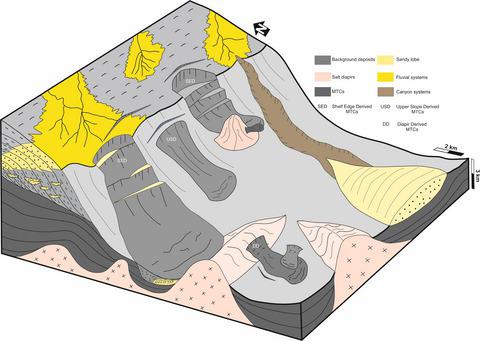当前位置:
X-MOL 学术
›
Basin Res.
›
论文详情
Our official English website, www.x-mol.net, welcomes your
feedback! (Note: you will need to create a separate account there.)
Mass‐transport complexes (MTCs) document subsidence patterns in a northern Gulf of Mexico salt minibasin
Basin Research ( IF 2.8 ) Pub Date : 2020-01-23 , DOI: 10.1111/bre.12429 Nan Wu 1 , Christopher A.‐L. Jackson 1 , Howard D. Johnson 1 , David M. Hodgson 2 , Harya D. Nugraha 1
Basin Research ( IF 2.8 ) Pub Date : 2020-01-23 , DOI: 10.1111/bre.12429 Nan Wu 1 , Christopher A.‐L. Jackson 1 , Howard D. Johnson 1 , David M. Hodgson 2 , Harya D. Nugraha 1
Affiliation

|
[Two types of MTCs (shelf‐edge/upper slope‐derived and diapir‐derived) are identified based on their geometry, volume and source area in a minibasin of the Northern Gulf of Mexico. Shelf‐edge/upper slope‐derived MTCs are relatively large and sourced from the collapse of coeval shelf‐edge deltas, or supplied by reworked upper slope channels and lobes. They are preferentially deposited during the earlier phase of minibasin development. Diapir‐derived MTCs tend to be smaller than shelf‐edge/upper slope‐derived MTCs, they are sourced from the collapse of the salt diapir flanks and deposited during the latest phase of minibasin development. , Abstract Mass‐transport complexes (MTCs) dominate the stratigraphic record of many salt‐influenced sedimentary basins. Commonly in such settings, halokinesis is invoked as a primary trigger for MTC emplacement, although the link between specific phases of salt movement, and related minibasin dynamics, remains unclear. Here, we use high‐quality 3D seismic reflection and well data to constrain the composition, geometry and distribution (in time and space) of six MTCs preserved in a salt‐confined, supra‐canopy minibasin in the northern Gulf of Mexico, and to assess how their emplacement relate to regional and local controls. We define three main tectono‐sedimentary phases in the development of the minibasin: (a) initial minibasin subsidence and passive diapirism, during which time deposition was dominated by relatively large‐volume MTCs (c. 25 km3) derived from the shelf‐edge or upper slope; (b) minibasin margin uplift and steepening, during which time small‐volume MTCs (c. 20 km3) derived from the shelf‐edge or upper slope were emplaced; and (c) active diapirism, during which time very small volume MTCs (c. 1 km3) were emplaced, locally derived from the diapir flanks or roofs. We present a generic model that emphasizes the dynamic nature of minibasin evolution, and how MTC emplacement relates to halokinetic sequence development. Although based on a single data‐rich case study, our model may be applicable to other MTC‐rich, salt‐influenced sedimentary basins.]
中文翻译:

质量传输复合体 (MTC) 记录了墨西哥湾北部盐小盆地的沉降模式
[根据墨西哥湾北部小盆地的几何形状、体积和源区,确定了两种类型的 MTC(陆架边缘/上坡衍生和底辟衍生)。陆架边缘/上斜坡衍生的 MTCs 相对较大,来源于同期陆架边缘三角洲的坍塌,或由改造后的上斜坡通道和裂片提供。它们优先沉积在小盆地开发的早期阶段。底辟衍生的 MTC 往往比陆架边缘/上坡衍生的 MTC 小,它们来源于盐底辟侧翼的塌陷,并在小盆地开发的最新阶段沉积。, 摘要 传质复合体 (MTCs) 在许多受盐影响的沉积盆地的地层记录中占主导地位。通常在这种情况下,光环运动被称为 MTC 就位的主要触发因素,尽管盐分运动的特定阶段与相关小盆地动力学之间的联系仍不清楚。在这里,我们使用高质量的 3D 地震反射和井数据来约束保存在墨西哥湾北部盐域上盖微型盆地中的六个 MTC 的组成、几何形状和分布(在时间和空间上),并评估它们的安置与区域和地方控制的关系。我们定义了小盆地发育的三个主要构造沉积阶段:(a) 初始小盆地沉降和被动底辟,在此期间沉积主要由来自陆架边缘或上坡;(b) 小盆地边缘抬升和变陡,在此期间,来自陆架边缘或上斜坡的小体积 MTC(约 20 km3)被侵占;(c) 活跃底辟,在此期间,从底辟侧翼或顶板局部产生了非常少量的 MTC(约 1 平方公里)。我们提出了一个通用模型,该模型强调小盆地演化的动态性质,以及 MTC 就位与卤代动力学序列开发的关系。尽管基于单个数据丰富的案例研究,我们的模型可能适用于其他富含 MTC 的受盐影响的沉积盆地。]
更新日期:2020-01-23
中文翻译:

质量传输复合体 (MTC) 记录了墨西哥湾北部盐小盆地的沉降模式
[根据墨西哥湾北部小盆地的几何形状、体积和源区,确定了两种类型的 MTC(陆架边缘/上坡衍生和底辟衍生)。陆架边缘/上斜坡衍生的 MTCs 相对较大,来源于同期陆架边缘三角洲的坍塌,或由改造后的上斜坡通道和裂片提供。它们优先沉积在小盆地开发的早期阶段。底辟衍生的 MTC 往往比陆架边缘/上坡衍生的 MTC 小,它们来源于盐底辟侧翼的塌陷,并在小盆地开发的最新阶段沉积。, 摘要 传质复合体 (MTCs) 在许多受盐影响的沉积盆地的地层记录中占主导地位。通常在这种情况下,光环运动被称为 MTC 就位的主要触发因素,尽管盐分运动的特定阶段与相关小盆地动力学之间的联系仍不清楚。在这里,我们使用高质量的 3D 地震反射和井数据来约束保存在墨西哥湾北部盐域上盖微型盆地中的六个 MTC 的组成、几何形状和分布(在时间和空间上),并评估它们的安置与区域和地方控制的关系。我们定义了小盆地发育的三个主要构造沉积阶段:(a) 初始小盆地沉降和被动底辟,在此期间沉积主要由来自陆架边缘或上坡;(b) 小盆地边缘抬升和变陡,在此期间,来自陆架边缘或上斜坡的小体积 MTC(约 20 km3)被侵占;(c) 活跃底辟,在此期间,从底辟侧翼或顶板局部产生了非常少量的 MTC(约 1 平方公里)。我们提出了一个通用模型,该模型强调小盆地演化的动态性质,以及 MTC 就位与卤代动力学序列开发的关系。尽管基于单个数据丰富的案例研究,我们的模型可能适用于其他富含 MTC 的受盐影响的沉积盆地。]











































 京公网安备 11010802027423号
京公网安备 11010802027423号